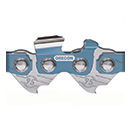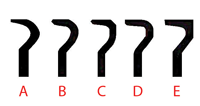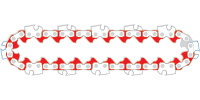Identification of a chainsaw chain

To identify the chain, you must know:
- Caliber
- No chain
- Type of gouge
Chain calibre
The chain size is the thickness of the drive link where it adjusts in the guide groove; it corresponds to the size of the guide. The size of the chain and the size of the guide shall be identical. Oregon offers many sizes for chain saws: 0.043 inches, 0.050 inches, 0.058 inches and 0.063 inches.

![]()
No chain
The chain step is the size of the chain and is defined as the distance between three consecutive rivets divided by two. The Oregon chain is made in many steps - 6.4 mm (1/4") is the smallest, 9.5 mm (3/8") is the most popular, 19.1 mm (3/4") is the largest chain for portable saws.
The step is important because the drive pinion step must be the same as that of the chain and, if necessary, the drive pinion of the bar. A simple way to determine the step of the chain is to look at the number marked on the guide link. See the chain and caliber step chart below.
![]()
Types of gouge

- Fragmenter
- Half scissors
- Scissor-shaft
- Microscissor
- Scissor
How do I measure the length of my chain?
The length of the chain is determined by counting the number of guide links in the chain. The number of guide links is included in the chainsaw chain part number after the chain type designation (e.g. 20BPX066, H66).
Note: The number of training links is related to the total size of your chain guide, which may vary depending on the manufacturer. Oregon chain guides could have a number of training links different from those of another brand.


Now that you know the details of your channel, you can find it and order it HERE
